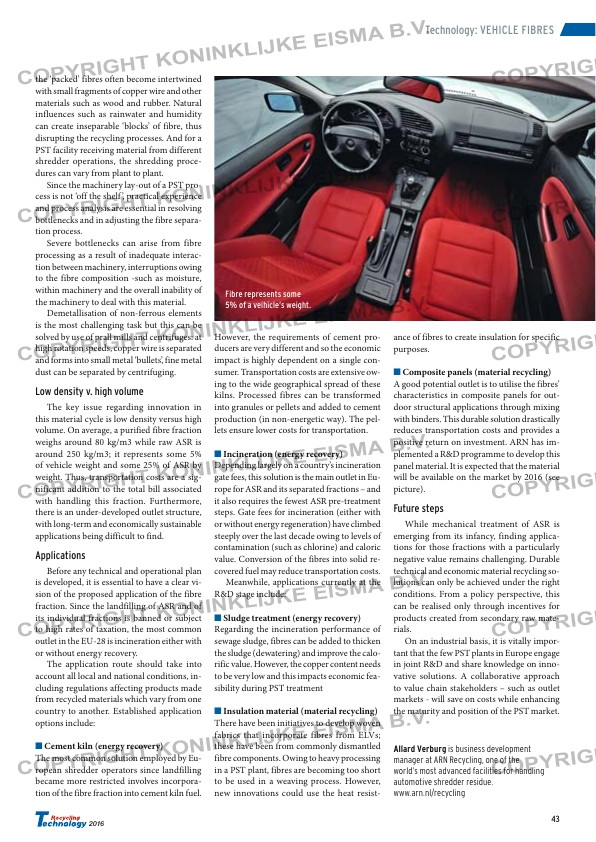Page 43 from: Recycling Technology 2016

43
2016
Technology: VEHICLE FIBRES
the ‘packed’ fibres often become intertwined
with small fragments of copper wire and other
materials such as wood and rubber. Natural
influences such as rainwater and humidity
can create inseparable ‘blocks’ of fibre, thus
disrupting the recycling processes. And for a
PST facility receiving material from different
shredder operations, the shredding proce-
dures can vary from plant to plant.
Since the machinery lay-out of a PST pro-
cess is not ‘off the shelf ’, practical experience
and process analysis are essential in resolving
bottlenecks and in adjusting the fibre separa-
tion process.
Severe bottlenecks can arise from fibre
processing as a result of inadequate interac-
tion between machinery, interruptions owing
to the fibre composition -such as moisture,
within machinery and the overall inability of
the machinery to deal with this material.
Demetallisation of non-ferrous elements
is the most challenging task but this can be
solved by use of prall mills and centrifuges: at
high rotation speeds, copper wire is separated
and forms into small metal ‘bullets’, fine metal
dust can be separated by centrifuging.
Low density v. high volume
The key issue regarding innovation in
this material cycle is low density versus high
volume. On average, a purified fibre fraction
weighs around 80 kg/m3 while raw ASR is
around 250 kg/m3; it represents some 5%
of vehicle weight and some 25% of ASR by
weight. Thus, transportation costs are a sig-
nificant addition to the total bill associated
with handling this fraction. Furthermore,
there is an under-developed outlet structure,
with long-term and economically sustainable
applications being difficult to find.
Applications
Before any technical and operational plan
is developed, it is essential to have a clear vi-
sion of the proposed application of the fibre
fraction. Since the landfilling of ASR and of
its individual fractions is banned or subject
to high rates of taxation, the most common
outlet in the EU-28 is incineration either with
or without energy recovery.
The application route should take into
account all local and national conditions, in-
cluding regulations affecting products made
from recycled materials which vary from one
country to another. Established application
options include:
Cement kiln (energy recovery)
The most common solution employed by Eu-
ropean shredder operators since landfilling
became more restricted involves incorpora-
tion of the fibre fraction into cement kiln fuel.
However, the requirements of cement pro-
ducers are very different and so the economic
impact is highly dependent on a single con-
sumer. Transportation costs are extensive ow-
ing to the wide geographical spread of these
kilns. Processed fibres can be transformed
into granules or pellets and added to cement
production (in non-energetic way). The pel-
lets ensure lower costs for transportation.
Incineration (energy recovery)
Depending largely on a country’s incineration
gate fees, this solution is the main outlet in Eu-
rope for ASR and its separated fractions – and
it also requires the fewest ASR pre-treatment
steps. Gate fees for incineration (either with
or without energy regeneration) have climbed
steeply over the last decade owing to levels of
contamination (such as chlorine) and caloric
value. Conversion of the fibres into solid re-
covered fuel may reduce transportation costs.
Meanwhile, applications currently at the
R&D stage include:
Sludge treatment (energy recovery)
Regarding the incineration performance of
sewage sludge, fibres can be added to thicken
the sludge (dewatering) and improve the calo-
rific value. However, the copper content needs
to be very low and this impacts economic fea-
sibility during PST treatment
Insulation material (material recycling)
There have been initiatives to develop woven
fabrics that incorporate fibres from ELVs;
these have been from commonly dismantled
fibre components. Owing to heavy processing
in a PST plant, fibres are becoming too short
to be used in a weaving process. However,
new innovations could use the heat resist-
ance of fibres to create insulation for specific
purposes.
Composite panels (material recycling)
A good potential outlet is to utilise the fibres’
characteristics in composite panels for out-
door structural applications through mixing
with binders. This durable solution drastically
reduces transportation costs and provides a
positive return on investment. ARN has im-
plemented a R&D programme to develop this
panel material. It is expected that the material
will be available on the market by 2016 (see
picture).
Future steps
While mechanical treatment of ASR is
emerging from its infancy, finding applica-
tions for those fractions with a particularly
negative value remains challenging. Durable
technical and economic material recycling so-
lutions can only be achieved under the right
conditions. From a policy perspective, this
can be realised only through incentives for
products created from secondary raw mate-
rials.
On an industrial basis, it is vitally impor-
tant that the few PST plants in Europe engage
in joint R&D and share knowledge on inno-
vative solutions. A collaborative approach
to value chain stakeholders – such as outlet
markets – will save on costs while enhancing
the maturity and position of the PST market.
Allard Verburg is business development
manager at ARN Recycling, one of the
world’s most advanced facilities for handling
automotive shredder residue.
www.arn.nl/recycling
Fibre represents some
5% of a veihicle’s weight.



